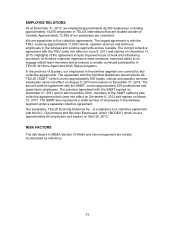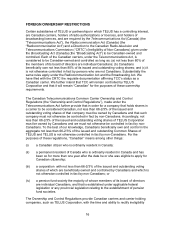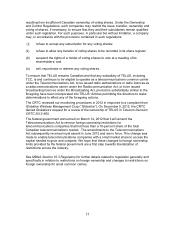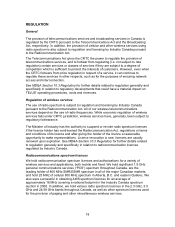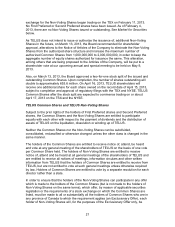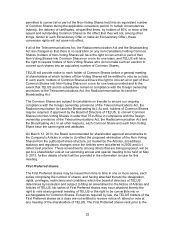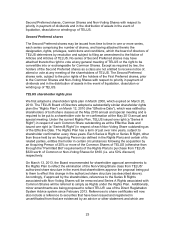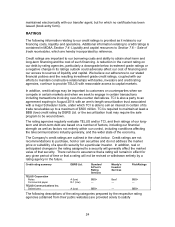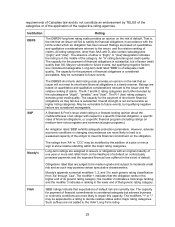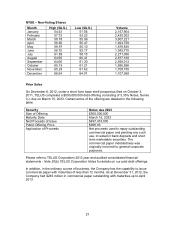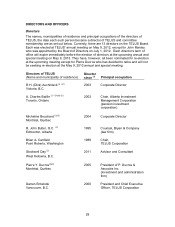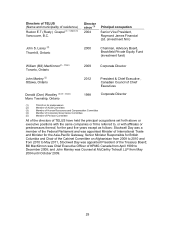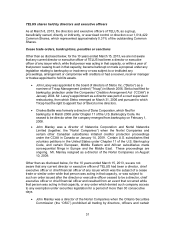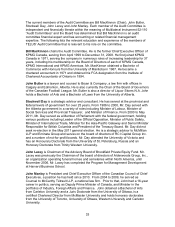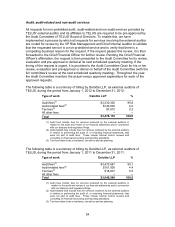Telus 2012 Annual Report Download - page 25
Download and view the complete annual report
Please find page 25 of the 2012 Telus annual report below. You can navigate through the pages in the report by either clicking on the pages listed below, or by using the keyword search tool below to find specific information within the annual report.
25
requirements of Canadian law and do not constitute an endorsement by TELUS of the
categories or of the application of the respective rating agencies.
Institution Rating
DBRS The DBRS® long-term rating scale provides an opinion on the risk of default. That is,
the risk that an issuer will fail to satisfy its financial obligations in accordance with the
terms under which an obligation has been issued. Ratings are based on quantitative
and qualitative considerations relevant to the issuer, and the relative ranking of
claims. All rating categories, other than AAA and D, also contain subcategories
“(high)” and “(low)”. The absence of either a “(high)” or “(low)”designation indicates
the rating is in the middle of the category. An “A” rating denotes good credit quality.
The capacity for the payment of financial obligations is substantial, but of lesser credit
quality than AA. May be vulnerable to future events, but qualifying negative factors
are considered manageable. Long-term debt rated “BBB” is of adequate credit
quality. The capacity for the payment of financial obligations is considered
acceptable. May be vulnerable to future events.
The DBRS® short-term debt rating scale provides an opinion on the risk that an
issuer will not meet its short-term financial obligations in a timely manner. Ratings are
based on quantitative and qualitative considerations relevant to the issuer and the
relative ranking of claims. The R-1 and R-2 rating categories are further denoted by
the subcategories “(high)”, “(middle)”, and “(low)”. The R-1 (low) rating category
denotes good credit quality. The capacity for the payment of short-term financial
obligations as they fall due is substantial. Overall strength is not as favourable as
higher rating categories. May be vulnerable to future events, but qualifying negative
factors are considered manageable.
S&P A Standard & Poor's issue credit rating is a forward-looking opinion about the
creditworthiness of an obligor with respect to a specific financial obligation, a specific
class of financial obligations, or a specific financial program (including ratings on
medium-term note programs and commercial paper programs).
An obligation rated ‘BBB’ exhibits adequate protection parameters. However, adverse
economic conditions or changing circumstances are more likely to lead to a
weakened capacity of the obligor to meet its financial commitment on the obligation.
The ratings from ‘AA’ to ‘CCC’ may be modified by the addition of a plus or minus
sign to show relative standing within the major rating categories.
Moody’s Long-term ratings are assigned to issuers or obligations with an original maturity of
one year or more and reflect both on the likelihood of a default on contractually
promised payments and the expected financial loss suffered in the event of default.
Obligations rated Baa are judged to be medium-grade and subject to moderate credit
risk and as such may possess certain speculative characteristics.
Moody's appends numerical modifiers 1, 2, and 3 to each generic rating classification
from ‘Aa’ through ‘Caa’. The modifier 1 indicates that the obligation ranks in the
higher end of its generic rating category; the modifier 2 indicates a mid-range ranking;
and the modifier 3 indicates a ranking in the lower end of that generic rating category.
Fitch 'BBB' ratings indicate that expectations of default risk are currently low. The capacity
for payment of financial commitments is considered adequate but adverse business
or economic conditions are more likely to impair this capacity. The modifiers "+" or "-"
may be appended to a rating to denote relative status within major rating categories.
Such suffixes are not added to the 'AAA' Long-Term rating


